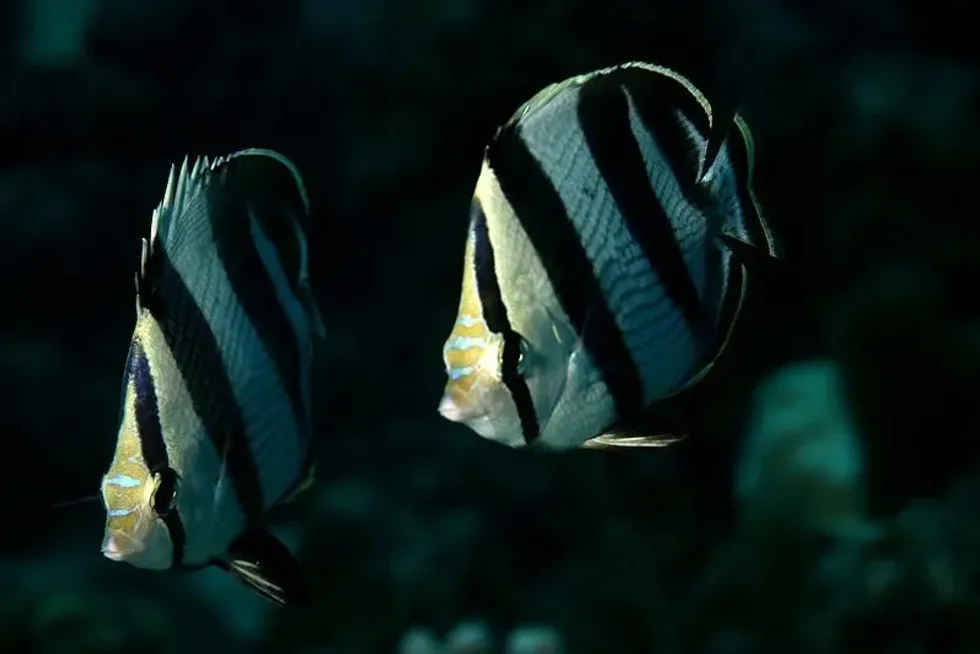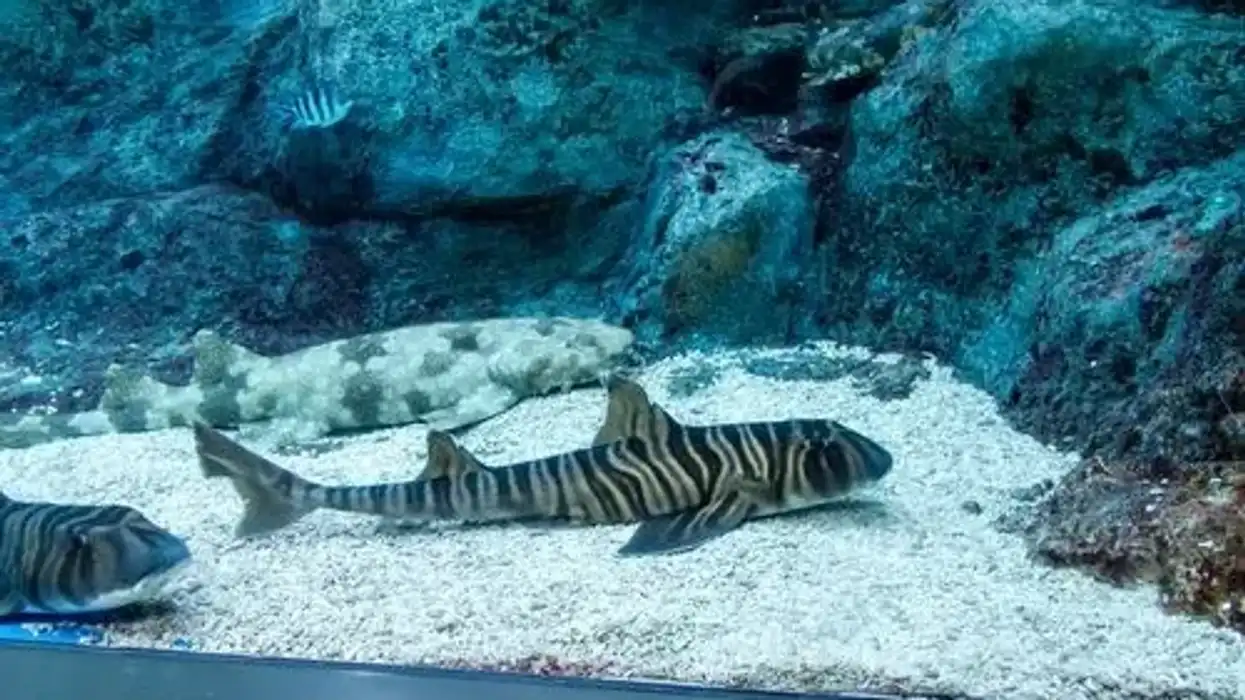Banded butterflyfish, Chaetodon striatus, also known by the names banded mariposas, butterbuns, butterfly fish, Portuguese butterflies, and schoolmistress, were first described by Carl Linnaeus in 1758.
These reef fish are small and flat and oval in shape, with pointed snouts and sloping foreheads full of spines and fins on their body.
The adult butterflyfish are white with strong vertical lines on their body with yellow highlights on their fins; however, the juveniles have darker colors and an eye-like spot on their dorsal fins, helping them confuse the predators from eating them. The banded butterflyfish are diurnal fish that are more active during the day and sleep at night.
They also seek shelter at night from the predators like moray eels, sharks, and other reef fishes.
Moreover, there are more than 130 species of butterflyfishes living in the world, most of which live in the coral reefs and many others in the deep ocean.
For more relatable content, check out these rockfish facts and manta ray facts for kids.
Banded Butterflyfish Interesting Facts
What type of animal is a banded butterflyfish?
The Chaetodon striatus, banded butterflyfish, is one of the butterflyfish species found in the world.
What class of animal does a banded butterflyfish belong to?
The Chaetodon striatus belongs to the Actinopterygii class of the family Chaetodontidae.
How many banded butterflyfish are there in the world?
The exact number of butterflyfish is not known, but since they are reef fish species of Least Concern conservation status, they are found in abundance in their habitat. It is believed that if a large number of butterfishes are seen diving, it indicates a healthy coral reef in that area since they require healthy corals as their food.
Where does a banded butterflyfish live?
Butterflyfish can be found in the western Atlantic from Massachusetts to Rio de Janerio, the Gulf of Mexico, and the Caribbean Sea. They can also be found off St. Pauls's Rocks in the central Atlantic.
What is a banded butterflyfish's habitat?
The banded butterflyfish habitat range mainly consists of coral reefs and is also associated with tropical marine reefs at a depth of 180.4 ft (55 m).
Who do banded butterflyfish live with?
This marine fish species can live alone or in pairs. Although sometimes the fish might also occur in small shoals of about 20 individuals for purposes of feeding.
How long does a banded butterflyfish live?
The lifespan of butterflyfishes ranges from three to possibly five years.
How do they reproduce?
The Chaetodon striatus fish are known to reproduce quickly, doubling their population every 15 months. Banded butterflyfish are known to be one of the monogamous fish species.
The adults stay in the same pair for life. The courtship happens between the adults by the fish circling each other head to tail; after that, they would chase each other around the nearest coral reef, where the female would release 3,000-4,000 small and pelagic eggs.
The reproduction takes place externally through spawning at dusk.
The eggs hatch within a day, and the larvae are usually gray in color, which takes up the color of juveniles in the next 24 hours. The juveniles have a large ringed black spot on their fin that looks like a false eye, which confuses the predators as to which is their front side.
Their overall body color is brownish-yellow instead of white. The juveniles change their color and lose the false eye as they grow into adults.
What is their conservation status?
Banded butterflyfish are a marine species of Least Concern conservation status. Even though they are harvested for the aquarium trade, their population is still in abundance. However, they face a coming threat since they rely a lot on the corals for feeding, which is affected due to climate change.
Banded Butterflyfish Fun Facts
What do banded butterflyfish look like?

The family name, Chaetodontidae, means that they are bristle toothed, and striatus means that they have thick black vertical stripes, two on the sides of their body and the third one extending from their dorsal fin to their caudal tail.
This striped butterflyfish has pelvic fins that are also black and has a short snout and a vertically flattened disk-shaped body.
The banded butterflyfish has 12 dorsal spines and 19-21 dorsal soft rays. They also have three anal spines and 16-17 anal soft rays.
Their body has a white color with black stripes on it. The fish has two wide strips on its mid-body and the third wide bar starting on the rear dorsal fin till the caudal peduncle.
How cute are they?
The banded butterflyfish are cute little fishes with black stripes on their body.
How do they communicate?
The three-banded butterflyfish species communicate with the members of their own species by making several sounds, and by releasing pheremones.
How big is a banded butterflyfish?
The banded butterflyfish is about 6.3 in (16 cm) in length, which twice smaller than the size of the ornate butterflyfish of the same family.
How fast can a banded butterflyfish swim?
The swimming speed range of the banded butterflyfish is unknown; however, it is known that the butterflyfish are quick-moving marine fishes.
How much does a banded butterflyfish weigh?
The average weight of the butterfishes is 0.7-2.8 oz (20-80 g) which is about the same as the freshwater butterflyfish.
What are the male and female names of the species?
The male and female butterflyfishes do not have any separate names.
What would you call a baby banded butterflyfish?
Baby butterflyfish are called larvae.
What do they eat?
60% of butterflyfishes are known to feed on coral reefs. They are obligatory corallivores and feed only coral polyps. They mostly feed on coral polyps, invertebrates, polychaete worms, crustaceans, and mollusk eggs. There are 5,000 fishes in the ocean that feed on coral reefs.
Are they dangerous?
The fish has no known harm to humans or the ecosystem. Moreover, in the ocean, they tend to ignore the divers and avoids any human interaction.
Would they make a good pet?
The butterflyfishes are peaceful and require moderate care; however, they possess an issue when it comes to feeding them. Their feeding should be done using meaty, vitamin-enriched, and color-enhancing food.
They should also not be kept in a reef aquarium as they would scrape and eat invertebrates using their teeth. Also, juveniles show better responses in an aquarium than adults. They would also help clean other fishes in an aquarium.
Did you know...
The butterflyfishes are known to occasionally clean parasites from other reef fishes in their group like grunts, parrotfishes, and surgeonfishes.
How do butterflyfish protect themselves?
The first instinct of a butterflyfish is to flee, but if they can't flee, they would assume a defensive posture. The fish would lower its head and erect its dorsal spines fully as a way to show the predators that the banded butterflyfish is too spiny to be eaten.
It would seek shelter from the night predators such as sharks, moray eels, and other large reef fishes at night time.
Why are butterflyfish called butterflyfish?
The banded butterflyfish was given the name Chaetodon striatus in 1758 by Linnaeus. The name 'Chaetodon' means bristle toothed, which describes the type of teeth found in the fish of this family.
And the name 'striatus' means lines in Latin, describing the band pattern on the fishs' body. The name also comes to form the long and prominent black spot near their tail.
Here at Kidadl, we have carefully created lots of interesting family-friendly animal facts for everyone to discover! Learn more about some other fish from our king salmon interesting facts and longhorn cowfish surprising facts pages.
You can even occupy yourself at home by coloring in one of our free printable rainbow trout jumping out of water coloring pages.









